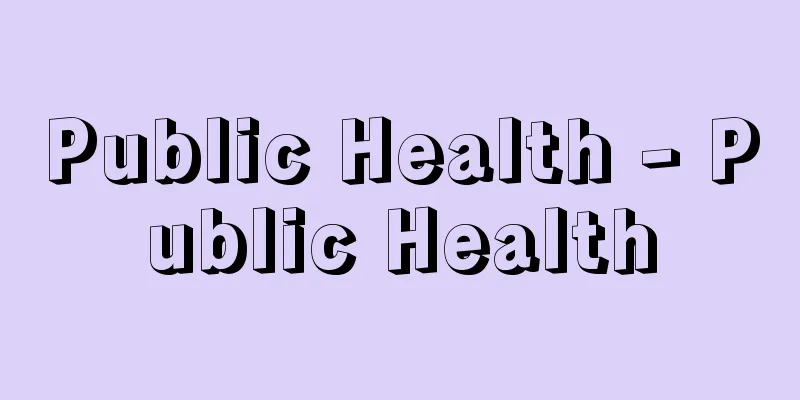Public Health - Public Health

|
Public health refers to organized social activities to enable people to live healthy lives. "Welfare and welfare" and "welfare" are systems that systematically carry out public health social activities at the administrative level, "global health" at the international level, "community health" at the local level, and "occupational health" at the workplace level. [Isao Okazaki] World HistoryBaths, drainage pipes, and stone brick drains in cities have been discovered in ruins of Ancient Egypt and India dating back to around 2100 BC, and large underground drains were built in the Roman era in the 6th century BC, and water supplies and hospitals in the 3rd century BC. The foundations for hospitals, universities, and public health systems were established around the 17th century. In 1700, the Italian B. Ramazzini (1633-1714) published Diseases of Working People, but from the late 18th century to the 19th century, the Industrial Revolution and the resulting concentration of population in cities led to widespread outbreaks of tuberculosis, typhoid, rickets, and occupational diseases, which led to the enactment of the Factory Act in England. Public health research as a measure against epidemics (plagues) began in 1854, when J. Snow (1813-84) proved that cholera was a waterborne infection, even before the rise of bacteriology. Smallpox vaccination, performed by Jenner in 1873, took 100 years to become widespread around the world, and in 1980 the World Health Organization (WHO) declared smallpox to have been eradicated. [Isao Okazaki] The role of WHOWHO was established in 1945, and in its constitution, it defines health as "a state of complete physical, mental and social well-being and not always the absence of disease or infirmity." WHO is focusing on combating AIDS, tuberculosis, and malaria, the three major infectious diseases in the world, while also working with national government agencies and non-governmental organizations (NGOs) to protect children from starvation and the lives and health of refugees who have lost their homes due to war. In addition, WHO discusses health issues of people all over the world, not only in developing countries but also in industrialized countries, and deals with international issues such as the harms of drugs, tobacco, and alcohol. In 1978, WHO adopted the declaration "Health for All by 2000" in Alma-Ata. In 2002, when Severe Acute Respiratory Syndrome (SARS) spread from Vietnam and China to the whole world, WHO issued a global alert for the first time in history. As one of the warnings, the WHO issued a "travel advisory," and, as a result of cooperation with various governments and research institutes, declared the containment of the outbreak in July 2003. WHO is also taking measures against the international threat of the outbreak and spread of new strains of influenza. [Isao Okazaki] History in JapanAs an activity that falls under the category of public health, Prince Shotoku established Japan's first medical institution, the Medical Hospital, at Shitennoji Temple in the 6th century. In the Edo period, the Tamagawa Aqueduct was established (1654), Kaibara Ekiken published "Yōjōkun" (1713), and the Vaccination Center was established at Kanda Otamagaike (1855). After the Meiji government was established, the Faculty of Medicine at the University of Tokyo was opened (1877), and the Infectious Disease Prevention Law, the Port Quarantine Law, the Sewage Cleaning Law, and the Sewage Law were established with reference to the public health administrative organizations of other countries, and the Ministry of Home Affairs' Health Bureau was established to oversee these. Tuberculosis was rampant from the end of the Meiji period to the Taisho period, and the Tuberculosis Prevention Law was enacted (1919). In the Showa period, the Public Health Center Law (1937) was enacted with the aim of enriching the country and strengthening its military, and in 1938 (Showa 13), the Ministry of Health and Welfare was separated from the Ministry of Home Affairs. Until then, infectious disease control was considered to be part of police administration, but the significance of it being separated as health administration is great. Furthermore, the American occupation policy after World War II brought about a major change in Japan's welfare administration. Despite the chaotic period after the defeat, thorough infectious disease control was implemented, and the improvement of national nutrition and tuberculosis control in local areas were mainly carried out by health centers. At that time, health centers played a major role in public health. The postwar confusion and poverty was transformed by the rise of industry during the Korean War, and against the backdrop of favorable economic development, the National Health Insurance System was launched (1961). Japan's maternal and child health programs progressed, and the mortality rate of mothers and children during childbirth became the lowest in the world. Furthermore, Japan became the world's number one country in terms of longevity, and the "Healthy Japan 21 Movement" was launched as a national movement to extend healthy lifespans without becoming bedridden, and the Health Promotion Act further emphasized the responsibility of individuals for their health (2002). Due to overeating and lack of exercise, 25% of the population is now suffering from metabolic syndrome and diabetes, and since 2008 the Ministry of Health, Labour and Welfare has made it mandatory for insurers to provide "specific health examinations and specific health guidance." [Isao Okazaki] assignmentWe have moved from the past, when many people died from the spread of acute infectious diseases, to an era of measures against chronic diseases caused by lifestyle-related diseases such as cancer, heart disease, cerebrovascular disorders, and diabetes. In addition to organized activities in communities, workplaces, schools, etc. aimed at preventing these diseases and promoting the health of individuals, there are also many public health issues to protect people's lives and health, such as environmental issues, crisis management against international terrorism, international disaster relief activities, measures against infectious diseases such as HIV/AIDS, highly pathogenic avian influenza, tuberculosis, and malaria against the backdrop of active global human exchange, care and support for the health and lifestyle of the elderly in a super-aging society, shortages of human, material, and economic resources due to the advancement of medical care, the virtual bankruptcy of the national health insurance system, and an increase in new socially vulnerable people due to the widening gap between rich and poor. Some issues can be solved by Japan alone, but many issues must be solved through international cooperation, such as measures against global warming and measures against imported infectious diseases such as HIV/AIDS, dengue fever, Ebola hemorrhagic fever, West Nile encephalitis, and highly pathogenic avian influenza. Tuberculosis has a high prevalence in developing countries, and in Japan the incidence rate in 2005 was 22.2 (per 100,000 population), higher than that of developed Western countries such as the United States at 4.7, the United Kingdom at 13.7, and France at 8.1, meaning that it is no longer a disease of the past (National Health Trends, 2007 and 2008, Health and Welfare Statistics Association). These days, public health issues cannot be discussed without considering society, politics, and the economy. Looking at medical care, the number of psychiatric outpatients ranks 12th out of 20 in the table "Medical Treatment Rate by Illness Classification" (Trends in National Health, 2008, Health and Welfare Statistics Association), and the number is increasing year by year. Mental distress is leading to an increase in suicides and depression, and medical professionals, including doctors, are unable to keep up with the demand for medical care. The burden of social problems is building up. As women advance into society, become more independent, and people's values become more diverse, people are getting married later in life and there are fewer children, which is causing major changes not only in social structure but also in medical care. Giving birth at an older age requires more human, material, and economic resources, and raising a small number of children places an excessive mental burden on mothers who are isolated in nuclear families, which has led to an increase in unexpected cases of child abuse. In nuclear families where both parents work during the day and during the day, there are many cases of children visiting pediatric emergency outpatient clinics at night. In addition, with advances in artificial pregnancy, transplants, gene therapy, and regenerative medicine, advanced medical care is increasingly developing to meet the needs of society. On the other hand, it is difficult to draw the line between what is a public health issue and what should be left to the individual, and ethical issues in public health are becoming more important. Article 25 of the Japanese Constitution proclaims the right of people to life and the right of health as a citizen's right, stating that "All people shall have the right to maintain the minimum standards of wholesome and cultured living," and that "The State shall endeavor in all spheres of life to improve and promote social welfare, social security, and public health." It declares that public health is an essential requirement for the right to life. However, there is a current situation in which at least 5 million people do not have health insurance cards, even though Japan is the nation with the world's longest life expectancy. In addition, how to support and care for the lives and health of the very elderly is being discussed, along with the burden on the people, and it is time to reconsider the quality of life as a dignified human being. Resolving and implementing such problems is the task of public health. [Isao Okazaki] "Standard Public Health and Social Medicine" edited by Isao Okazaki, Hideaki Toyoshima, and Renki Kobayashi (2008, Igaku-Shoin)" ▽ "National Health Trends 2008" edited and published by the Health and Welfare Statistics Association" ▽ "P. Basch: Textbook of International Health (1999, Oxford University Press)" [References] | | | | | | | | | | | |Source: Shogakukan Encyclopedia Nipponica About Encyclopedia Nipponica Information | Legend |
|
公衆衛生とは、人間が健康に生活できるための組織的社会活動をいう。「厚生福祉」「福利厚生」は行政レベルで、「国際保健」は国際的レベルで、「地域保健」は地域レベルで、そして「職域保健」は職場レベルで公衆衛生の社会活動を組織的に展開する制度である。 [岡崎 勲] 世界の歴史古く紀元前2100年ころの古代エジプトおよびインドの遺跡から、浴室、排水管、都市における石煉瓦(れんが)の排水溝が発見され、ローマ時代紀元前6世紀に地下大排水溝が、紀元前3世紀ころに上水道、病院が建設されている。病院・大学・公衆衛生制度の基盤がつくられたのは17世紀ころである。1700年にはイタリアのラマッツィーニB. Ramazzini(1633―1714)による『働く人々の病気』が出版されているが、18世紀後半から19世紀にかけては産業革命とそれに伴う人口の都市への集中から、結核、腸チフス、くる病、職業病が多発し、イギリスでは工場法が制定された。 流行病(疫病)対策としての公衆衛生研究は、スノーJ. Snow(1813―84)が、コレラは水系感染であることを細菌学の勃興以前である1854年に証明したことに始まる。1873年にジェンナーによって行われた種痘は、100年を要して世界に普及し、1980年には世界保健機関(WHO)が天然痘の撲滅を宣言している。 [岡崎 勲] WHOの役割WHOは1945年に設立され、その憲章のなかで、健康とは「完全な肉体的、精神的及び社会的福祉の状態であり、常に疾病又は病弱の存在しないことではない」と定義している。WHOは世界三大感染症のエイズ(AIDS)、結核、マラリア対策に力を入れる一方、飢餓から子供を救う、また戦争で住む場所を失った難民の生活および健康を守る活動を、各国政府機関および非政府組織(NGO)と連携して行っている。さらに開発途上国にとどまらず工業先進国など世界中の人々の健康問題を討議し、麻薬、タバコ、飲酒禍など国際間の問題を扱っている。WHOは1978年アルマ・アタにて「西暦2000年までにすべての人々に健康を(Health for All by 2000)」の宣言を採択した。2002年、重症急性呼吸器症候群(SARS)がベトナム、中国から全世界に波及する事態に、WHOは史上初めて世界に向けて警報(global alert)を発するに及んだ。警報の一つとして「渡航延期勧告」を出し、各国政府および研究機関と連携した結果、2003年7月に集団感染の封じ込めを宣言した。また、新型インフルエンザの発生と流行という国際的脅威に対しても、WHOを中心に対策がとられている。 [岡崎 勲] 日本での歴史公衆衛生の範疇(はんちゅう)に入る活動として、6世紀、聖徳太子が日本初の医療機関である療病院を四天王寺に設立した。江戸時代には玉川上水の設置(1654)、貝原益軒の『養生訓』(1713)の出版、神田お玉ヶ池の種痘所の設置(1855)などがみられる。明治政府となってからは、東京大学医学部の開設(1877)に続き、諸外国の衛生行政組織を参考としながら伝染病予防法、海港検疫法、汚物掃除法、下水法が整備され、さらに内務省衛生局が発足し、これらを統括した。明治時代末期から大正時代にかけて結核が猛威を振るい、結核予防法が制定された(1919)。昭和に至り、富国強兵の観点から保健所法(1937)が制定され、1938年(昭和13)には内務省から厚生省が独立した。それまで感染症対策などは警察行政の一環として考えられていた向きがあったが、保健行政として独立したことの意義は大きい。さらに、第二次世界大戦後におけるアメリカの占領政策は、日本の厚生行政を大きく転換するものであった。敗戦後の混乱期にもかかわらず徹底した感染症対策がとられ、地域における国民栄養の向上、結核対策が保健所を中心に行われた。このときに保健所が公衆衛生に果たした役割は大きい。戦後の混乱と貧困はその後の朝鮮動乱期の産業の勃興でさま変わりし、好調な経済発展を背景に、国民皆保険制度が発足した(1961)。日本の母子保健事業は進捗し、出産に伴う母子の死亡率は世界でもっとも低くなった。また、日本は世界第1位の長寿国となったが、寝たきりなどのない、健康寿命を延命すべく国民運動として「健康日本21運動」が展開され、さらに健康増進法で個人の健康への責任が強調されてきた(2002)。飽食、運動不足などからメタボリック症候群や糖尿病の発症が国民の25%にみられるようになり、2008年(平成20)から厚生労働省は保険者に「特定健康診査・特定保健指導」を義務付けている。 [岡崎 勲] 課題かつての、急性感染症の蔓延(まんえん)から多数の死亡者が出た時代から、癌(がん)、心臓病、脳血管障害、糖尿病などの生活習慣病による慢性疾患対策の時代へと変化した。それら疾病の予防、個人の健康増進を目的とする地域、職域、学校などでの組織的活動はもちろん、環境問題、国際的テロに対する危機管理、国際的な災害救助活動、世界的な人的交流の活発化を背景にしたHIV・AIDS、高病原性トリインフルエンザ、結核、マラリアなどの感染症の対策、超高齢化社会における高齢者の健康・生活などの介護・支援、医療の高度化による人的・物的・経済的資源の不足、国民皆保険制度の実質的破産の状態、貧富の格差拡大による新たな社会的弱者の増加など、人々の生活と健康を守るための公衆衛生の課題は広がり、山積している。日本だけで解決できることもあれば、地球温暖化対策や、HIV・AIDS、デング熱、エボラ出血熱、西ナイル脳炎、高病原性トリインフルエンザなどの輸入感染症対策など、国際的に協調して解決すべき問題も多い。開発途上国で高い有病率の結核は、日本でも2005年の罹患率22.2(人口10万人)と、アメリカ4.7、イギリス13.7、フランス8.1などの欧米先進国より有病率、発生率が高く、過去の病気ではない(『国民衛生の動向』2007年、2008年 厚生統計協会)。 いまや公衆衛生の問題は社会、政治、経済を抜きにしては論議できない。医療についてみてみると、精神科外来受診者数は、「傷病分類別にみた受療率」の表(『国民衛生の動向』2008年 厚生統計協会)で20項目中12位となっており、その数は年々増加する傾向にある。精神的苦痛が自殺者やうつ病の増加をもたらし、それに対して医師を含めた医療従事者のサービスは追いつかない状況にある。社会問題のしわよせが医療需要を押し上げることとなっている。 女性の社会進出、自立および人々の価値観の多様化から晩婚化や少子化がみられ、社会構造だけでなく医療にも大きな変化がみられる。高齢出産はより多くの人的・物的・経済的資源を必要とし、数少ない子供の養育も、核家族で孤立した母親に過剰な精神的負担を強い、思いもかけない児童虐待などの増加をきたしている側面もある。日中共働きする核家族では、夜間に小児救急外来を受診する事例が多い。また、人工妊娠、移植、遺伝子治療、再生医学の進歩などから高度医療はますます社会のニーズに対応して発展している。一方、どこまでが公衆衛生の問題で、どこからが個人にゆだねられるべきかの線引きも難しく、公衆衛生の倫理的問題が重視されてきている。日本国憲法25条は「すべて国民は、健康で文化的な最低限度の生活を営む権利を有する」「国は、すべての生活部面について、社会福祉、社会保障及び公衆衛生の向上及び増進に努めなければならない」として国民の生存権、および国民の権利としての健康を謳(うた)っており、公衆衛生が国民の生存権に必須の要件であることを宣言している。翻って、国民皆保険制度のなかで保険証をもっていない人が少なくとも500万人以上いるという現状がある。また、世界第1位の長寿国となったが、超高齢者の生活と健康をどう支え介護していくのか、国民の負担とあわせて議論されるなど、尊厳ある人間としての生命の質を見直す時期に来ている。こうした問題の解決と実践が公衆衛生の課題である。 [岡崎 勲] 『岡崎勲・豊嶋英明・小林廉毅(編)『標準公衆衛生・社会医学』(2008・医学書院)』▽『厚生統計協会編・刊『国民衛生の動向2008』』▽『P. Basch :Textbook of International Health(1999, Oxford University Press)』 [参照項目] | | | | | | | | | | | |出典 小学館 日本大百科全書(ニッポニカ)日本大百科全書(ニッポニカ)について 情報 | 凡例 |
Recommend
Yuè jué shū (English spelling)
A book that records the rise and fall of the state...
Original - Ganso
〘 noun 〙① The first in a family line. Also, the pe...
Kürten, P. (English spelling) KurtenP
…(3) Sadistic pleasure killing. Seeing the agony ...
Brittany - Bretagne
Historical region and old province name in northw...
Index Society
…The British magazines Punch and Illustrated Lond...
Borrowed scenery
A style of Japanese gardens. It is a technique th...
Elementary particle physics - Soryuushibutsurigaku (English spelling) elementary particle physics
This field aims to clarify the most fundamental la...
Parasitism
It refers to an organism that lives inside or on ...
EPA (Eicosapentaenoic Acid)
It is one of the polyunsaturated fatty acids that ...
Siraf (English spelling)
…They traveled as far as India and China. At that...
Chlorous acid - aensosan (English spelling) chlorous acid
Chemical formula: HClO 2 . It is an unstable acid ...
Mallory-Weiss syndrome
This is a disease in which a laceration occurs nea...
Copper ammine complex salt
Also called cuprammonium complex salt. A general t...
Osaka magistrate - Osakamachibugyo
One of the Edo Shogunate's distant province m...
《Edigay》 - Edigay
...They speak the Turkic language Nogai, and in t...









